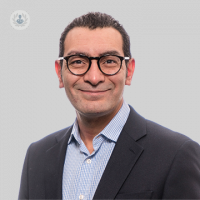When you can't catch your breath: all about shortness of breath
Escrito por:Shortness of breath, also known as dyspnoea, feels as though not enough air is getting into the lungs. It can be incidental or The chest will be tense, and breathing will be shallow, requiring effort to inhale and exhale. There are several reasons as to why someone may be struggling with shortness of breath, ranging from psychological to internal issues of the cardiopulmonary system. In this article, respected cardiologist Dr Ahmed Elghamaz goes through common causes of shortness of breath.

Shortness of breath, also known as dyspnoea, can be accompanied by wheezing, heart palpitations, and feelings of panic. Dyspnoea is not dangerous on its own, but if prolonged and accompanied by choking, fading vision, chest pain, swelling limbs, and blueing fingers and lips, then emergency medical services will be required.
There are two types of shortness of breath: acute (meaning suddenly occurring, and lasting a few hours to days) and chronic (meaning long-lasting, such as for weeks or longer).
Acute shortness of breath can be caused by:
- anaphylaxis (allergic reaction)
- asthma
- COVID-19
- pneumonia or other lung infections
- anxiety and panic attacks
- a history of smoking
- pulmonary embolism
- blockage in the airways (choking)
- blunt force trauma or injuries to the chest
Chronic shortness of breath can be caused by:
- asthma
- chronic obstructive pulmonary disease (COPD)
- heart dysfunction
- obesity
- lung cancer
- heart failure
Chronic shortness of breath is likely to be a symptom of more serious cardiopulmonary diseases or illnesses, and should be assessed by a doctor so they may investigate the cause and give a formal diagnosis. If there is not enough air and oxygen in the body, then it cannot function properly. The condition of the heart and lungs is not to be taken lightly as both are vital for the wellbeing of the body.
To complete the diagnostic process, the doctor may also do additional tests aside from the physical exam, such as X-rays or CT scans, blood tests, and cardiopulmonary exercise tests (CPET).
To help manage shortness of breath, it is recommended to exercise more so that the muscles, heart, and lungs are strengthened and the anaerobic threshold is increased. For patients with anxiety disorders, learning breathing techniques and relaxation practices can help counteract dyspnoea. Patients with asthma and COPD can be prescribed inhalers to help relax the muscles around the airway and let more air in. Smokers are encouraged to cease in order to mitigate dyspnea.
If you are experiencing chronic or acute shortness of breath, Dr Ahmed Elghamaz is available for consultation via his Top Doctors profile.


